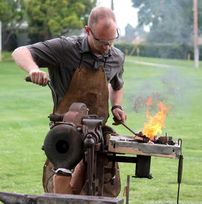|
Today I am going to be taking the time to give a lesson in the history of blacksmithing. On this historical tour we will visit several aspects of blacksmithing and I will share my knowledge of mechanics, resourcefulness and anthropology. Today's topic: blowing hot air. More specifically, I want to talk about different ways in which to supply oxygen to the forge. When the average American thinks about blacksmithing he or she tends to think of the medieval European scene with a blacksmith and his apprentice pounding away at a misshapen sword, dunking it in water while it's still red hot and then sticking it back in the fire. (word to the would be bladesmith, please don't do that, it ruins the metal). Usually some sort of wooden bellows is thrown in the mix because it "looks medieval". That's the image Hollywood has branded on our brains. While water, hammers and a big anvil are all important to the forging process, all this would be hard to do if there was no heat. You may remember from your science classes that fire needs three things to keep going. Fuel, heat, and oxygen. Many of today's commercial forges use natural gas or propane as their fuel source so as long as ambient air is let into the firing chamber there is no problem with airflow. I use coal when I forge because I like how it works for me. Coal is actually a bit hard to keep burning. Once I have it lit it can easily go out three minutes later if I don't have at least some air flow coming from below my fire. So how do I get air to my fire? I should be easy, right? Actually, yes, it is. I use a what is called a "blower". It does as it's name suggests: it forces air to go someplace it wasn't before. There are many kinds of blowers out there; some of these include hand bellows, fans or even pistons.
Earlier than that we have the bellows, a simple device easily made with two boards and an air proof (or at least resistant) material like leather or fabric. This device uses at least two separate holes to function. One is the output. The other is the intake, which has a flap that allows air in when the bellows is pulled apart and closes when the bellows are squeezed. An improvement on this design was the double bellows that was essentially two bellows attached to each other so that on both up and down strokes of the operating lever. (https://medievalfoundry.wordpress.com/2014/11/17/the-origin-and-use-of-bellows-especially-in-medieval-europe/)
Throughout the ages there were many different ways blacksmiths used to force air into their forges. The only limit they had was not creativity, but resources. I was fortunate enough to come across a hand crank blower when I did but in other places there is not as many resources as I had. When a lot people think of sub-Saharan Africa they don't think of the expert metalwork that the peoples from there do. Indeed blacksmithing is probably the furthest thing from one's mind when they think of Africa, even if they the weapons that are used by some of the peoples there. (https://anthromuseum.missouri.edu/minigalleries/africanaxes/intro.shtml) Believe it or not, many of the tribal people, who have had little access to western influence in ages past have been using and mastering blacksmithing for thousands of years. (http://portal.unesco.org/en/ev.php-URL_ID=3432&URL_DO=DO_TOPIC&URL_SECTION=201.html) I first learned about these blacksmiths when I was reading through the book Practical Blacksmithing from Weathervane Books. (http://www.amazon.com/Practical-Blacksmithing-Original-Classic-Illustrations/dp/051725025X) It's a great book that is a compilation of letters and lessons from the early 1900s about various tools, tricks and techniques of the business of blacksmithing. Included are some interesting notes on the history of blacksmithing and blacksmithing in other cultures. Anyways, I was intrigued by the ingenuity of the smiths in that they used skins as their blower by attaching the to hollow logs and pumping them. I was able to find a video of one in action. Here is the link to the video: http://www.anvilfire.com/AnvilCAM-II/index.php?video=zulu_blacksmiths He ones in he film appear to be make from goat skins but there are cases of banana leaves being used for this purpose. As I was doing research on African blacksmiths I found an intriguing thing about some African cultures, blacksmiths tend to be seen as outcasts and set apart from the rest of the tribe. Olivier Gosselain of the University of Brussels took a trip to the Cameroon to investigate this. "I was questioning Dowayo informants in northern Cameroon about the reasons for segregating both blacksmiths and potters." He said in one of his articles,
He proceeded to ask if the bellows is indeed the source of this "cough" and is told the idea had not occurred to anyone in his tribe. Being more of a functionalist myself and experiencing blacksmithing, I know that here are hazards with the smoke which can cause coughing and sickness. For this it seems the blacksmiths are not only seen as tool makers but also as bringers of illness, essentially a "necessary evil". So to conclude this historical tour let's recap. Today we can electric blowers and gas fuel for todays metalwork. Before we had electric motors we could use hand cranked blowers and bellows. And perhaps the most important thing we talked about, blacksmithing is not a strictly medieval or European thing. It is global and there are different perceptions of the character of the smiths themselves. As one final lesson in forced air delivery, there is also the easiest to build but not so easy to use blowpipe. All it is a pipe stuck in the fire and blow into it. It's simplicity is breathtaking. Forging On (or at least doing household chores), Stephen
1 Comment
16/8/2019 01:14:23
Forging a sword is one of my many dreams. Well, I am a huge nerd and I really love weapons. I started studying and learning about how to be a blacksmith. I know that this is not a career that is in demand, but that is why I want to do it. I am a man who wants to preserve the culture of forging weaponry. I hope that I become a good blacksmith in the future, it will be a dream come true.
Reply
Leave a Reply. |
AuthorStephen is a professional archaeologist in the Riverside area and the sole proprietor of For the Honor Forge. Archives
April 2018
Categories |


 RSS Feed
RSS Feed